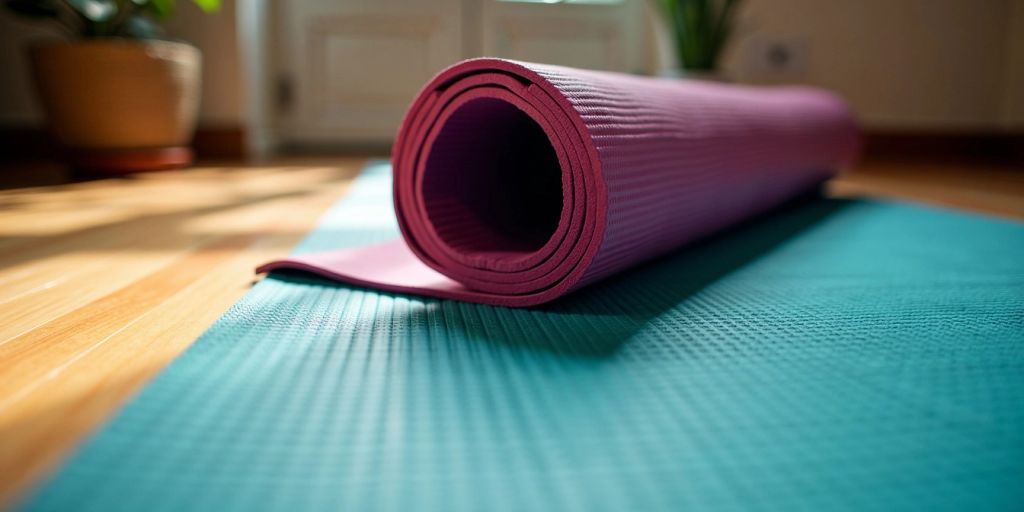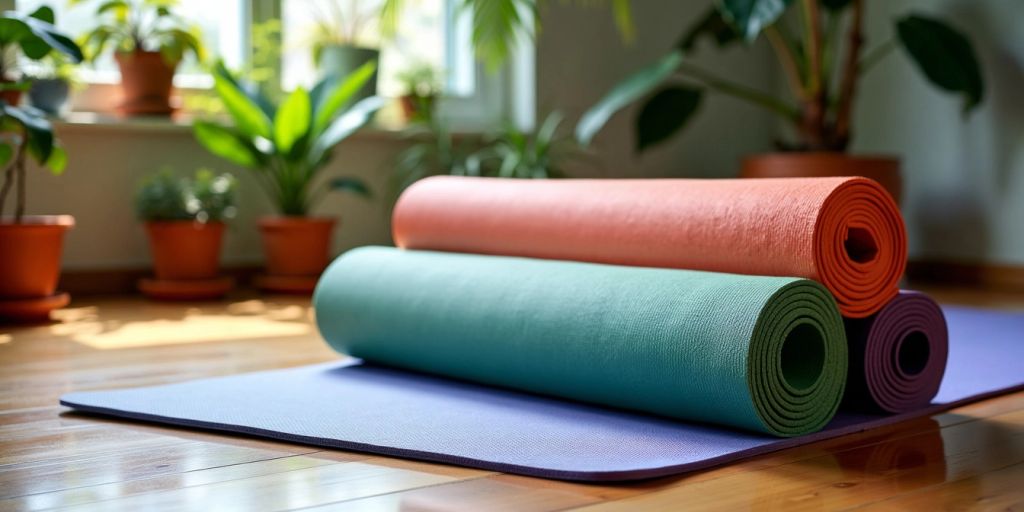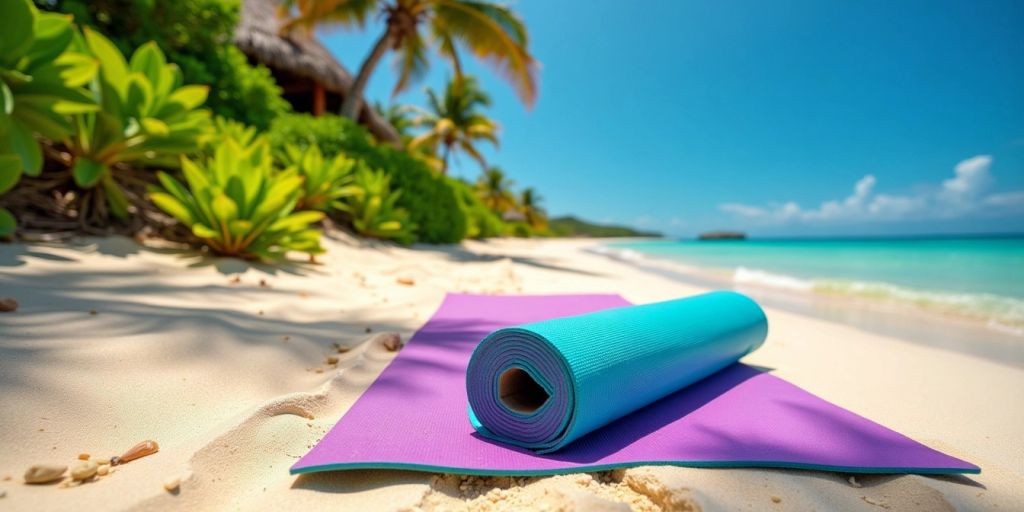
Discover the Best Yoga Mat No Slip for Ultimate Stability and Comfort
Yoga is all about finding balance and stability, and having the right mat can make a big difference in your practice. A non-slip yoga mat helps you stay grounded, even during the toughest poses. In this article, we will explore the best non-slip yoga mats that provide both comfort and support, ensuring you can focus on your flow without worrying about slipping. Let's dive into the key features to look for, compare popular mats, and understand the benefits of using a non-slip mat.
Key Takeaways
- Look for mats made from durable materials that can withstand regular use.
- Choose a mat with excellent grip to prevent slipping during your practice.
- Consider the thickness of the mat for added comfort and support.
- Eco-friendly options are available, so you can practice sustainably.
- Read user reviews to find the best mat that fits your needs.
Top Features to Look for in the Best Yoga Mat No Slip
When searching for the best yoga mat no slip, there are several key features to consider that can enhance your practice. Here’s what to look for:
Material and Durability
Choosing a mat made from high-quality materials is essential. Look for options that are durable and can withstand regular use. Common materials include natural rubber, PVC, and TPE. Each has its own benefits, but natural rubber is often praised for its grip and eco-friendliness.
Grip and Traction
A non-slip mat should provide excellent grip, even during sweaty sessions. Many mats feature a textured surface or a no-slip dot pattern on the bottom layer, which helps keep the mat firmly in place, regardless of the surface. This is crucial for maintaining stability during challenging poses.
Thickness and Cushioning
The thickness of a yoga mat can greatly affect comfort and stability. Generally, a thickness of 1/8 to 1/4 inch is ideal, providing a balance between cushioning and support. A thicker mat can help protect your joints, especially during floor exercises.
Eco-Friendliness
For environmentally conscious yogis, consider mats made from sustainable materials. Look for options that are biodegradable or made from recycled materials. This not only benefits the planet but also ensures that your practice is aligned with your values.
A good yoga mat should not only support your practice but also reflect your commitment to sustainability.
| Feature | Importance |
|---|---|
| Material | Affects durability and grip |
| Grip and Traction | Prevents slipping during poses |
| Thickness | Provides comfort and joint support |
| Eco-Friendliness | Aligns with sustainable practices |
Comparing Popular Non-Slip Yoga Mats

When it comes to choosing the right non-slip yoga mat, several options stand out for their unique features and benefits. Here’s a closer look at some of the most popular mats available today:
Liforme Yoga Mat
- Exceptional grip: This mat is known for its innovative grip technology, ensuring stability even during dynamic poses.
- Eco-friendly materials: Made from natural rubber, it’s a sustainable choice for eco-conscious yogis.
- Alignment markers: Helps practitioners maintain proper posture.
Manduka Pro Yoga Mat
- Top-rated overall: The Manduka Pro is celebrated for its durability and comfort, making it ideal for all levels of practice.
- Dense cushioning: Provides excellent support for joints during various poses.
- Long-lasting: Built to withstand years of use without losing its grip.
Jade Harmony Professional Mat
- Natural rubber construction: Offers great traction and support, especially for vigorous sessions.
- Eco-friendly: Made from sustainable materials, it’s a favorite among environmentally conscious users.
Gaiam Performance Dry-Grip Yoga Mat
- Moisture-wicking surface: This mat ensures a steady grip, even in sweaty conditions.
- Dual-sided design: Offers versatility for different yoga styles.
- Lightweight: Easy to transport, making it great for travel.
| Yoga Mat | Grip Quality | Thickness | Eco-Friendly | Price |
|---|---|---|---|---|
| Liforme Yoga Mat | Excellent | 4.2 mm | Yes | $120 |
| Manduka Pro Yoga Mat | Superior | 6 mm | Yes | $120 |
| Jade Harmony Professional Mat | Good | 5 mm | Yes | $80 |
| Gaiam Performance Dry-Grip | Good | 5 mm | No | $50 |
Choosing the right mat can greatly enhance your yoga experience. Finding the perfect balance between grip, comfort, and eco-friendliness is key to enjoying your practice.
Benefits of Using a Non-Slip Yoga Mat
Enhanced Stability
Using a non-slip yoga mat provides better stability during your practice. This is crucial for maintaining balance in various poses, especially when you’re sweating. A mat with a good grip helps you stay grounded, allowing you to focus on your movements without worrying about slipping.
Improved Safety
Safety is a top priority in yoga. A non-slip mat reduces the risk of injuries caused by slipping. This is particularly important for beginners or those practicing more dynamic styles of yoga. With a secure surface, you can perform poses confidently, knowing you won’t lose your footing.
Better Performance
When you have a stable base, your performance improves. You can hold poses longer and transition smoothly between them. This leads to a more fulfilling practice, as you can concentrate on your breathing and alignment without distractions.
Increased Comfort
Comfort is key in yoga. A non-slip mat often features extra cushioning, which provides support for your joints. This is especially beneficial during longer sessions or when practicing on hard surfaces. A comfortable mat allows you to enjoy your practice without discomfort.
Investing in a quality non-slip yoga mat can significantly enhance your yoga experience, making it easier to get your zen on.
| Feature | Benefit |
|---|---|
| Grip and Traction | Prevents slipping |
| Thickness | Provides cushioning |
| Material Quality | Enhances durability and comfort |
| Eco-Friendliness | Supports sustainable practices |
How to Choose the Best Yoga Mat No Slip for Your Practice
Choosing the right non-slip yoga mat is essential for enhancing your practice. Here are some key factors to consider:
Assessing Your Yoga Style
- Identify your practice type: Different styles, like hot yoga or vinyasa, may require different mat features.
- Consider your experience level: Beginners might need more cushioning, while advanced practitioners may prioritize grip.
Considering Your Environment
- Indoor vs. outdoor: If you practice outside, look for mats that resist moisture and dirt.
- Temperature: For hot yoga, ensure your mat can handle sweat without becoming slippery.
Evaluating Material Preferences
- Natural rubber: Known for its excellent grip and eco-friendliness, making it a popular choice.
- PVC: Often more affordable but may not be as durable or eco-friendly.
Budget and Value
- Set a budget: Quality mats can range from $20 to over $100. Determine what you can afford.
- Look for durability: A more expensive mat may last longer, providing better value over time.
Remember, the best yoga mat is one that fits your personal needs and enhances your practice.
By considering these factors, you can find a mat that offers the ultimate stability and comfort, allowing you to focus on your poses without worrying about slipping. For example, mats made from natural rubber are often recommended for their grip and durability, while those designed for hot yoga may feature moisture-wicking surfaces to keep you steady during intense sessions.
Ultimately, the right mat will support your journey towards balance and wellness, making your practice more enjoyable and effective.
Maintenance Tips for Your Non-Slip Yoga Mat
Keeping your non-slip yoga mat in great shape is essential for a safe and enjoyable practice. Here are some tips to help you maintain your mat:
Regular Cleaning
- Wipe down your mat after each use with a mild soap solution or a vinegar-water mix. This helps remove sweat and bacteria.
- For deeper cleaning, soak your mat in a gentle soap solution and rinse thoroughly. Avoid harsh chemicals that can damage the material.
Proper Storage
- Store your mat in a cool, dry place away from direct sunlight. This prevents fading and material degradation.
- Roll your mat instead of folding it to maintain its shape and prevent creases.
Handling Wear and Tear
- Inspect your mat regularly for signs of wear, such as cracks or peeling. If you notice significant damage, it may be time to replace it.
- Use a yoga towel on top of your mat during sweaty sessions to enhance grip and protect the mat's surface.
Extending Mat Lifespan
- Follow the manufacturer's care instructions for specific cleaning and maintenance guidelines. This ensures you keep your mat in the best condition possible.
- Consider using accessories like yoga towels to help prevent slipping on your yoga mat with these tips.
Maintaining your non-slip yoga mat is crucial for ensuring a safe and effective yoga practice. Regular care not only enhances grip but also extends the life of your mat, allowing you to focus on your poses without worry.
Eco-Friendly Options for the Best Yoga Mat No Slip

When it comes to yoga mats, choosing an eco-friendly option can make a big difference. Here are some great choices that are both sustainable and effective:
Natural Rubber Mats
- Made from 100% sustainably harvested natural tree rubber.
- Provides excellent grip and durability.
- Biodegradable and free from harmful chemicals.
Recycled Material Mats
- Constructed from recycled materials, reducing waste.
- Often lightweight and easy to transport.
- Offers good traction and cushioning.
Biodegradable Mats
- Designed to break down naturally over time.
- Made from plant-based materials, ensuring a lower environmental impact.
- Ideal for yogis who want to minimize their carbon footprint.
Sustainable Brands
- Look for brands that prioritize eco-friendly practices in their manufacturing.
- Many companies now offer mats that are both high-quality and environmentally conscious.
Choosing an eco-friendly yoga mat not only supports your practice but also helps protect the planet.
By selecting a mat made from natural or recycled materials, you can enjoy your yoga sessions while being kind to the environment. Remember, the right mat can help you find your balance on the best non-slip yoga mat, enhancing your overall experience!
User Reviews and Testimonials
Real-Life Experiences
Many users have shared their thoughts on various non-slip yoga mats. For instance, one user mentioned that the Jade Yoga Harmony Mat offers unwavering support, making it a favorite among both experienced yogis and beginners. This mat is praised for its non-slip assurance, which enhances stability during practice.
Expert Opinions
Experts also weigh in on the best mats. A yoga instructor highlighted the Liforme Yoga Mat for its superior grip and comfort, stating that it has made their practice more enjoyable and stable, even during challenging poses. The eco-friendly materials used in this mat are an added bonus.
Comparative Feedback
Here's a quick comparison of user ratings for popular non-slip yoga mats:
| Yoga Mat | User Rating (out of 5) |
|---|---|
| Jade Yoga Harmony Mat | 4.8 |
| Liforme Yoga Mat | 4.7 |
| Manduka Pro Yoga Mat | 4.6 |
| Gaiam Performance Dry-Grip | 4.5 |
Long-Term Usage Insights
Many users report that their non-slip mats maintain their grip and comfort over time. Regular users often mention that investing in a quality mat pays off in the long run, as it enhances their overall yoga experience.
"A good yoga mat can change your practice. It’s worth finding one that feels right for you!"
Conclusion
Picking the right non-slip yoga mat can really improve your yoga experience. It helps you stay stable and comfy, so you can focus on your poses and meditation. The five mats we talked about have different features, like eco-friendly materials and special grip designs, making sure there's something for everyone. When choosing your mat, think about the material, thickness, and texture that work best for you. In the end, the best yoga mat is the one that fits your personal goals and helps you on your journey to balance and wellness. Enjoy your practice!
Frequently Asked Questions
What makes a yoga mat non-slip?
A non-slip yoga mat usually has a textured surface or special materials that give extra grip. This helps keep your hands and feet from sliding, even when you're sweating during tough poses.
How should I clean my non-slip yoga mat?
To clean your mat, mix a little soap with water or use a cleaner made for yoga mats. Wipe it down with a soft cloth, rinse it with clean water, and let it air dry. Avoid strong chemicals and keep it out of direct sunlight to keep it in good shape.
Can I use these mats for hot yoga?
Yes, most non-slip yoga mats work well for hot yoga because they are designed to provide grip even when you're sweating. Just make sure to check if the mat can handle the heat and moisture.
Are non-slip yoga mats eco-friendly?
Many non-slip yoga mats are made from eco-friendly materials like natural rubber or recycled stuff. Always look at the product details to see how it affects the environment.
What thickness is best for a non-slip yoga mat?
The best thickness for a non-slip yoga mat can vary, but most people like mats that are between 4 to 6 millimeters thick. This gives a good balance of comfort and support.
How can I make my non-slip yoga mat last longer?
To extend the life of your mat, clean it regularly, store it properly, and handle any wear and tear with care. Avoid leaving it in hot places or direct sunlight.


